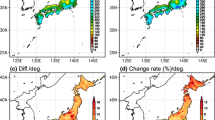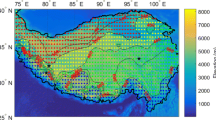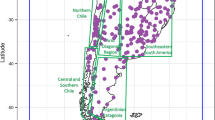Abstract
Self-organizing map (SOM) is used to simulate summer daily precipitation over the Yangtze–Huaihe river basin in Eastern China, including future projections. SOM shows good behaviors in terms of probability distribution of daily rainfall and spatial distribution of rainfall indices, as well as consistency of multi-model simulations. Under RCP4.5 Scenario, daily rainfall at most sites (63%) is projected to shift towards larger values. For the early 21st century (2016–2035), precipitation in the central basin increases, yet decreases occur over the middle reaches of the Yangtze River as well as a part of its southeast area. For the late 21st century (2081–2100), the mean precipitation and extreme indices experience an overall increase except for a few southeast stations. The total precipitation in the lower reaches of the Yangtze River and in its south area is projected to increase from 7% at 1.5 °C global warming to 11% at 2 °C, while the intensity enhancement is more significant in southern and western sites of the domain. A clustering allows to regroup all SOM nodes into four distinct regimes. Such regional synoptic regimes show remarkable stability for future climate. The overall intensification of precipitation in future climate is linked to the occurrence-frequency rise of a wet regime which brings longitudinally closer the South Asia High (eastward extended) and the Western Pacific Subtropical High (westward extended), as well as the reduction of a dry pattern which makes the two atmospheric centers of action move away from each other.












Similar content being viewed by others
References
Borah N, Sahai AK, Chattopadhyay R (2013) A self-organizing map—based ensemble forecast system for extended range prediction of active/break cycles of Indian summer monsoon. JGR Atmos 118:9022–9034. https://doi.org/10.1002/jgrd.50688
Chattopadhyay R, Sahai AK, Goswami BN (2008) Objective identification of nonlinear convectively coupled phases of monsoon intraseasonal oscillation: implications for prediction. J Atmos Sci 65:1549–1569. https://doi.org/10.1175/2007JAS2474.1
Chen WL, Jiang ZH, Huang Q (2012) Projection and simulation of climate extremes over the Yangtze and Huaihe River Basins based on a Statistical Downscaling Model. Trans Atmos Sci 35(5):578–590. https://doi.org/10.1007/s11783-011-0280-z
Chen X, Xu Y, Yao Y (2015) Changes in climate extremes over China in a 2 °C, 3 °C, and 4 °C warmer world. Chin J Atmos Sci 39:1123–1135. https://doi.org/10.3878/j.issn.1006-9895.1502.14224
Corti S, Molteni F, Palmer T (1999) Signature of recent climate change in frequencies of natural atmospheric circulation regimes. Nature 398:799. https://doi.org/10.1038/19745
Fan L, Fu C, Chen D (2005) Review on creating future climate change scenarios by statistical downscaling techniques. Adv Earth Sci 20:320–329. https://doi.org/10.1007/s10409-004-0010-x
Fowler HJ, Blenkinsop S, Tebaldi C (2007) Linking climate change modelling to impacts studies: recent advances in downscaling techniques for hydrological modelling. Int J Climatol 27:1547–1578. https://doi.org/10.1002/joc.1556
Frich P, Alexander LV, Della-Marta P, Gleason B, Haylock M, Tank AK, Peterson T (2002) Observed coherent changes in climatic extremes during the second half of the twentieth century. Clim Res 19:193–212. https://doi.org/10.3354/cr019193
Fu G, Liu Z, Charles SP, Xu Z, Yao Z (2013) A score-based method for assessing the performance of GCMs: a case study of southeastern Australia. J Geophys Res: Atmos 118:4154–4167. https://doi.org/10.1002/jgrd.50269
Gao X, Xu Y, Zhao ZC (2006) Impacts of Horizontal Resolution and Topography on the Numerical Simulation of East Asian Precipitation. Chin J Atmos Sci 02:185–192. https://doi.org/10.1016/S1003-6326(06)60040-X
Guo L, Jiang Z, Ding M, Chen W, Li L (2019) Downscaling and projection of summer rainfall in Eastern China using a nonhomogeneous hidden Markov model. Int J Climatol 39:1319–1330. https://doi.org/10.1002/joc.5882
Hewitson B, Crane R (2006) Consensus between GCM climate change projections with empirical downscaling: precipitation downscaling over South Africa. Int J Climatol 26:1315–1337. https://doi.org/10.1002/joc.1314
Hope PK (2006) Projected future changes in synoptic systems influencing southwest Western Australia. Clim Dyn 26:765–780. https://doi.org/10.1007/s00382-006-0116-x
Hope PK, Drosdowsky W, Nicholls N (2006) Shifts in the synoptic systems influencing southwest Western Australia. Clim Dyn 26:751–764. https://doi.org/10.1007/s00382-006-0115-y
IPCC (2013) Climate change 2013: The physical science basis. Cambridge University Press, pp 1535. https://doi.org/10.1017/CBO9781107415324
Kohonen T (1982) Self-organized formation of topologically correct feature maps. Biol Cybern 43:59–69. https://doi.org/10.1007/BF00337288
Kohonen T (1990) The self-organizing map. Proc IEEE 78:1464–1480. https://doi.org/10.1109/5.58325
Liu W, Wang L, Chen D, Tu K, Ruan C, Hu Z (2016) Large-scale circulation classification and its links to observed precipitation in the eastern and central Tibetan Plateau. Clim Dyn 46:3481–3497. https://doi.org/10.1007/s00382-015-2782-z
MacQueen J (1967) Some methods for classification and analysis of multivariate observations. Proceedings of the fifth Berkeley symposium on mathematical statistics and probability, Oakland, CA, USA, 281–297
Ning L, Mann ME, Crane R, Wagener T (2012a) Probabilistic projections of climate change for the mid-Atlantic region of the United States: validation of precipitation downscaling during the historical era. J Clim 25:509–526. https://doi.org/10.1175/2011JCLI4091.1
Ning L, Mann ME, Crane R, Wagener T, Najjar RG Jr, Singh R (2012b) Probabilistic projections of anthropogenic climate change impacts on precipitation for the mid-Atlantic region of the United States. J Clim 25:5273–5291. https://doi.org/10.1175/JCLI-D-11-00565.1
Perkins S, Pitman A, Holbrook N, McAneney J (2007) Evaluation of the AR4 climate models’ simulated daily maximum temperature, minimum temperature, and precipitation over Australia using probability density functions. J Clim 20:4356–4376. https://doi.org/10.1175/JCLI4253.1
Salinger M, Griffiths G (2001) Trends in New Zealand daily temperature and rainfall extremes. Int J Climatol 21:1437–1452. https://doi.org/10.1002/joc.694
Salvi K, Kannan S, Ghosh S (2013) High-resolution multisite daily rainfall projections in India with statistical downscaling for climate change impacts assessment. JGR Atmos 118:3557–3578. https://doi.org/10.1002/jgrd.50280
Shi C, Jiang ZH, Chen WL, Li L (2018) Changes in temperature extremes over China under 1.5 °C and 2 °C global warming targets. Adv Clim Change Res 9:120–129. https://doi.org/10.1016/j.accre.2017.11.003
Taylor KE (2001) Summarizing multiple aspects of model performance in a single diagram. J Geophys Res Atmos 106:7183–7192. https://doi.org/10.1029/2000jd900719
Ultsch A (2007) Emergence in self-organizing feature maps. H Ritter, R Haschke (Eds), International Workshop on Self-Organizing Maps (WSOM ‘07), Neuroinformatics Group, Bielefeld, Germany, ISBN 978-3-00-022473-7
Verdon-Kidd D, Kiem A (2009) On the relationship between large-scale climate modes and regional synoptic patterns that drive Victorian rainfall. Hydrol Earth Syst Sci 13:467–479. https://doi.org/10.5194/hessd-5-2791-2008
Wang Y, Jiang Z, Chen W (2015) Performance of CMIP5 models in the simulation of climate characteristics of synoptic patterns over East Asia. J Meteorol Res 29:594–607. https://doi.org/10.1007/s13351-015-4129-4
Wilby RL, Charles S, Zorita E, Timbal B, Whetton P, Mearns L (2004) Guidelines for use of climate scenarios developed from statistical downscaling methods. Supporting material of the Intergovernmental Panel on Climate Change, available from the DDC of IPCC TGCIA 27
Wu D, Jiang ZH, Ma TT (2016) Projection of summer precipitation over the Yangtze–Huaihe River basin using multimodel statistical downscaling based on canonical correlation analysis. J Meteorol Res 30:867–880. https://doi.org/10.1007/s13351-016-6030-1
Xu CY, Singh VP (2004) Review on regional water resources assessment models under stationary and changing climate. Water Resour Manag 18:591–612. https://doi.org/10.1007/s11269-004-9130-0
Xu Y, Gao X, Giorgi F, Zhou B, Shi Y, Wu J, Zhang Y (2018) Projected changes in temperature and precipitation extremes over China as measured by 50-yr return values and periods based on a CMIP5 ensemble. Adv Atmos Sci 35:376–388. https://doi.org/10.1007/s00376-017-6269-1
Yin C, Li Y, Ye W, Bornman JF, Yan X (2011) Statistical downscaling of regional daily precipitation over southeast Australia based on self-organizing maps. Theor Appl Climatol 105:11–26. https://doi.org/10.1007/s00704-010-0371-y
Zhang X et al (2011) Indices for monitoring changes in extremes based on daily temperature and precipitation data. Wiley Interdiscip Rev Clim Change 2:851–870. https://doi.org/10.1002/wcc.147
Zhao C, Jiang ZH, Sun XJ, Li W, Li L (2019) How well do climate models simulate regional atmospheric circulation over East Asia? Int J Climatol. https://doi.org/10.1002/joc.6205
Zhou P, Jiang ZH (2016) Statistical downscaling of regional daily precipitation over Yangtze-Huai River basin based on Self-Organizing Maps. Clim Environ Res 21:512–524. https://doi.org/10.1007/s00704-010-0371-y
Zhou B, Wen QH, Xu Y, Song L, Zhang X (2014) Projected changes in temperature and precipitation extremes in China by the CMIP5 multimodel ensembles. J Clim 27:6591–6611. https://doi.org/10.1175/JCLI-D-13-00761.1
Acknowledgements
We acknowledge the climate modeling groups listed in Table 1 of this paper for making their simulations available, the PCMDI for collecting and archiving the CMIP5 model output, and World Climate Research Programme’s Working Group on Coupled Modeling. This study is supported by the National Key Research and Development Program of China (2017YFA0603804, 2018YFC1507704), and the National Natural Science Foundation of China (41675081). L Li and H Le Treut acknowledge the support of French ANR (Project China-Trend-Stream). Three anonymous reviewers are acknowledged for their constructive comments to improve an earlier version of the manuscript. The authors also declare that they have no conflict of interest.
Author information
Authors and Affiliations
Corresponding author
Additional information
Publisher's Note
Springer Nature remains neutral with regard to jurisdictional claims in published maps and institutional affiliations.
Appendix: Example of SOM nodes and associated rainfall cumulative probability distributions for Wuhan station
Appendix: Example of SOM nodes and associated rainfall cumulative probability distributions for Wuhan station
This appendix shows an example (for Wuhan) illustrating how SOM is used as a climate downscaling tool. The 20 SOM synoptic patterns are shown in Fig. 13 and the corresponding precipitation cumulative probability distribution functions (CDF) are shown in Fig. 14. It can be seen that the frequency of each pattern is between 2 and 9%, and the quantization errors are all controlled below 11 with a uniform distribution on different patterns, indicating that each pattern possesses expected and almost homogeneous capability to reflect information of its corresponding samples. The upper left patterns in Fig. 13 are dominated by lower humidity and higher SLP with northerly dry wind anomaly, while the lower right by higher humidity and lower SLP with southwest wet wind. Patterns in the middle are “transition patterns”. Moreover, circulation states of adjacent patterns are similar to each other, while far-away patterns are greatly different. This is an indication that the 20 patterns together have the expected capability in reflecting overall information and synoptic evolution (distributions and variations of circulation elements) at this station. Based on the above SOM synoptic patterns, the CDF of rainfall corresponding to each pattern is obtained (Fig. 14). Similar behaviors can be observed as for the SOM synoptic patterns: CDFs of adjacent SOM synoptic patterns are similar to each other, and show obvious differences for far-away patterns. A joint inspection for what shown in Figs. 13 and 14 reveals expected results, that is, a lack of rainfall corresponds to a combination of higher SLP, lower humidity and northerly dry wind and abundant rainfall takes place in the opposite situation of lower SLP, higher humidity and southwest wet wind. This provides evidence that the relationship between SOM synoptic patterns and observed rainfall is reasonable, and different SOM synoptic patterns can reflect different distribution characteristics of rainfall.
The 5 × 4 nodes of the Self-organizing map (SOM) obtained for Wuhan station and during the training process (1961–2002) of the neural network. Anomalous fields, as a deviation from their mean climatology, are plotted or superimposed for each node. The green contours show sea-level pressure (SLP) anomaly (green solid lines: positive; green dashed lines: negative and zero) (unit: hPa); Arrows represent 850-hPa wind (unit: m s−1, only plotted when amplitude larger than 0.5 m s−1); 850-hPa relative humidity anomalies (unit: %) are shown in shading (negative in red and positive in blue). The purple frame depicts the position of our interested area, the Yangtze–Huaihe river basin. The letter ‘h’ above each panel represents occurrence fraction (%) of the pattern, the letter ‘qe’ is quantization error calculated as the sum of the absolute differences of all states forming the cluster from the cluster mean
Cumulative probability distribution function (CDF) of precipitation at Wuhan station, corresponding to the SOM nodes shown in Fig. 13 for the training period (1961–2002)
Rights and permissions
About this article
Cite this article
Li, M., Jiang, Z., Zhou, P. et al. Projection and possible causes of summer precipitation in eastern China using self-organizing map. Clim Dyn 54, 2815–2830 (2020). https://doi.org/10.1007/s00382-020-05150-4
Received:
Accepted:
Published:
Issue Date:
DOI: https://doi.org/10.1007/s00382-020-05150-4






